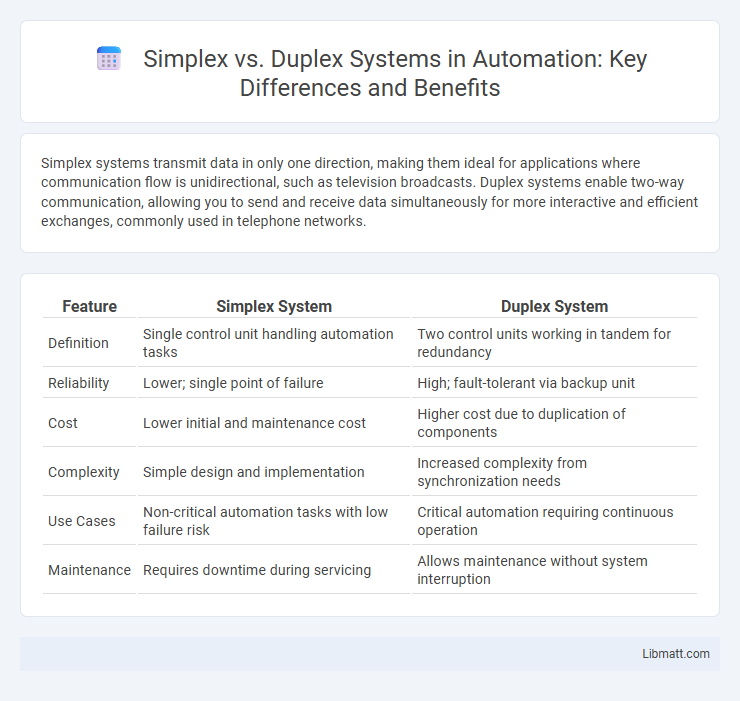Simplex systems transmit data in only one direction, making them ideal for applications where communication flow is unidirectional, such as television broadcasts. Duplex systems enable two-way communication, allowing you to send and receive data simultaneously for more interactive and efficient exchanges, commonly used in telephone networks.
Table of Comparison
| Feature | Simplex System | Duplex System |
|---|---|---|
| Definition | Single control unit handling automation tasks | Two control units working in tandem for redundancy |
| Reliability | Lower; single point of failure | High; fault-tolerant via backup unit |
| Cost | Lower initial and maintenance cost | Higher cost due to duplication of components |
| Complexity | Simple design and implementation | Increased complexity from synchronization needs |
| Use Cases | Non-critical automation tasks with low failure risk | Critical automation requiring continuous operation |
| Maintenance | Requires downtime during servicing | Allows maintenance without system interruption |
Introduction to Simplex and Duplex Systems
Simplex and Duplex systems represent two fundamental communication methods in data transmission. A Simplex system allows data to flow in only one direction, making it ideal for applications like keyboard-to-computer inputs or broadcast signals. Duplex systems enable two-way communication, with Half-Duplex allowing alternated transmission and Full Duplex supporting simultaneous data exchange, enhancing efficiency in your network interactions.
Definition of Simplex System
A Simplex system is a communication method where data flows in only one direction, from the sender to the receiver, without any capability for the receiver to send data back. This unidirectional data transmission is commonly used in devices like keyboards, traditional television broadcasts, and public address systems. Unlike Duplex systems, which allow two-way communication, Simplex systems support only one-way communication, making them ideal for situations where feedback or response from the receiver is unnecessary.
Definition of Duplex System
The Duplex System refers to a communication or data transmission method that allows simultaneous two-way transfer between devices, enhancing efficiency and reducing latency. Unlike the Simplex System, which supports only one-way communication, Duplex Systems enable real-time interaction crucial for applications such as telephony and network communications. Full-duplex and half-duplex are two types of Duplex Systems, with full-duplex supporting simultaneous bidirectional transmission and half-duplex allowing two-way communication but not at the same time.
Key Differences: Simplex vs Duplex System
Simplex systems transmit data in a single direction, allowing communication only one way, which is ideal for applications like keyboard to CPU data flow. Duplex systems provide two-way communication, either half-duplex (one direction at a time) or full-duplex (simultaneous two-way), enhancing efficiency in devices like telephones and network connections. The key difference lies in the directionality and timing of data transmission--simplex offers unidirectional flow, while duplex supports bidirectional communication.
Transmission Modes: One-Way vs Two-Way Communication
Simplex systems enable one-way communication where data flows in a single direction, making them suitable for applications like keyboard-to-computer input. Duplex systems support two-way communication, allowing simultaneous sending and receiving of data, essential for devices like telephones and network connections. Understanding these transmission modes helps you choose the right system based on your communication needs.
Applications of Simplex Systems
Simplex systems are primarily used in applications where communication is one-way, such as traditional broadcast television, radio transmission, and keyboard-to-computer communication. These systems are ideal for scenarios that require consistent data flow without the need for feedback or two-way interaction. Understanding the limitations and use cases of simplex systems helps you choose the right communication setup for unidirectional signal transmission.
Applications of Duplex Systems
Duplex systems are widely used in telecommunications, enabling simultaneous two-way communication, which is essential for telephone networks, mobile radios, and internet data transmission. They also play a critical role in wireless communication systems, including walkie-talkies and satellite communication, where continuous bidirectional data flow is necessary. Industrial automation and control systems rely on duplex systems to maintain real-time monitoring and feedback, enhancing operational efficiency and safety.
Advantages and Disadvantages of Simplex System
Simplex systems offer simplicity and lower cost due to their unidirectional communication, making them ideal for basic data transmission where feedback is unnecessary. However, their inability to send information back limits error correction and dynamic interaction, reducing reliability in complex applications. You should consider a simplex system when your communication needs are straightforward and cost efficiency is a priority, but not when two-way communication is essential.
Advantages and Disadvantages of Duplex System
The Duplex system provides the advantage of simultaneous two-way communication, enhancing real-time interaction and improving efficiency, especially in telecommunication and networking environments. Its main disadvantage is the increased cost and complexity due to the need for more sophisticated hardware and infrastructure to support bidirectional data flow. Despite this, Duplex systems are favored in scenarios requiring continuous and immediate feedback, such as video conferencing and online gaming.
Choosing Between Simplex and Duplex Systems
Choosing between simplex and duplex systems depends on the application's reliability requirements and budget constraints. Simplex systems provide unidirectional communication suitable for basic, cost-effective installations, while duplex systems enable bidirectional communication, enhancing fault tolerance and operational control. Industries prioritizing continuous operation typically opt for duplex systems to minimize downtime and maintain data integrity.
Simplex System vs Duplex System Infographic

 libmatt.com
libmatt.com